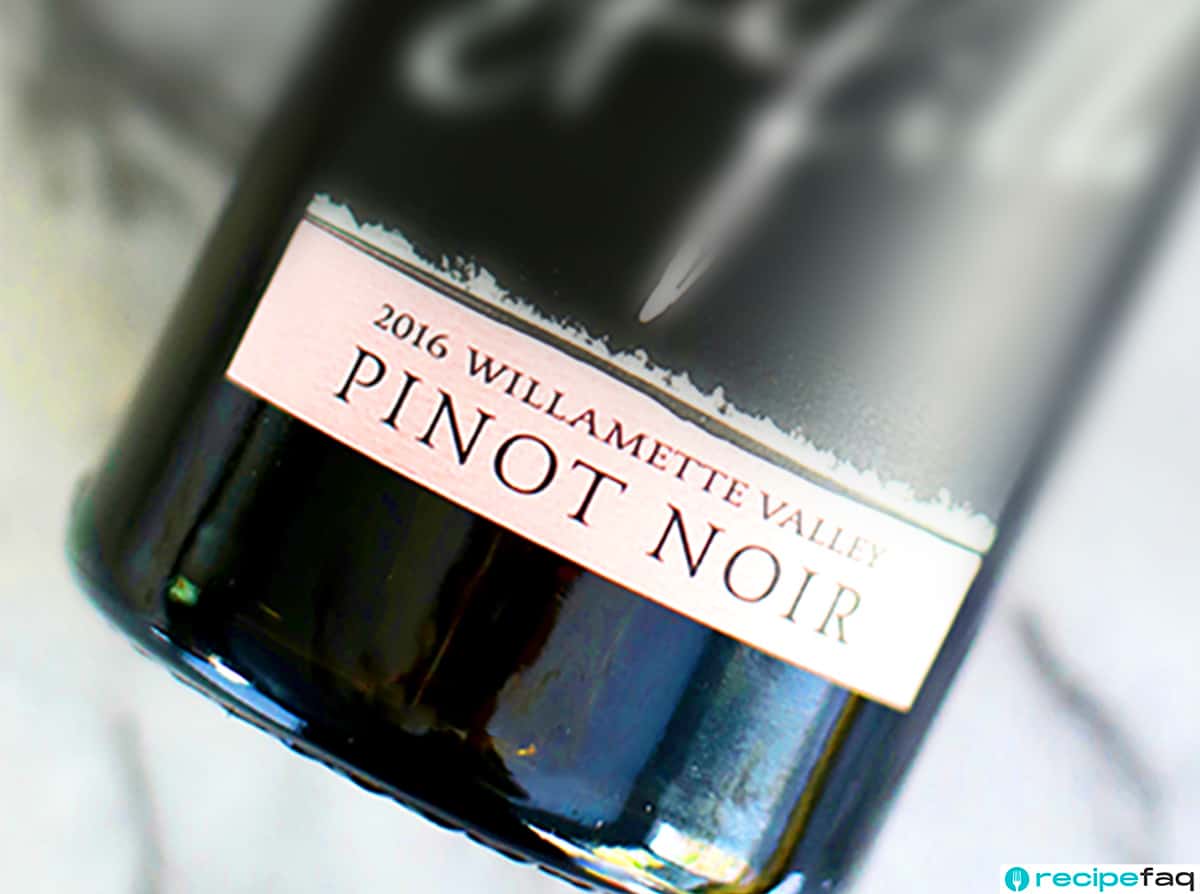They are two of the world’s most popular types of wine. But they have some clear distinctions, in addition to their color. Here are the main differences between Pinot Grigio vs Pinot Noir.

Pinot Noir and Pinot Grigio. One is a red wine and the other a white, but the grapes that go into making these well-liked varietals aren’t as different as you may think.
Where and how they’re grown and produced is what really sets the wines apart, and has made them so popular. Today, the grapes rank among the top 10 in wine production worldwide.
So, what’s the difference between Pinot Grigio and Pinot Noir? Or Pinot Gris vs Pinot Noir? Here’s your guide.


Jump to:
The origin of the Pinot Grigio and Pinot Noir grape
You may be surprised to learn that Pinot Noir and Pinot Grigio (or Pinot Gris depending on growing region) are mutations of the same grape, as is its cousin Pinot Blanc. Confused yet? Don’t worry, we’ll explain everything.
The grape that’s common to these wines hails from the Burgundy region of France, and dates to earlier than the first century AD. Romans conquering the Gaul region — which later became France — witnessed locals fermenting the grape and making wine from it, and they adopted the practice.
Over the centuries, its popularity grew. Now Pinot Noir is Burgundy’s most widely grown red wine grape.
One of the defining characteristics of Pinot Noir grapes is its thin skin, which can leave it more vulnerable to developing rot and disease brought on by unusually hot or cold temperatures. So Burgundy’s cool climates and well-draining, chalky soil are ideal for nurturing the difficult-to-grow grape.
The Pinot Grigio white grape mutation — known as the Pinot Gris grape in France — spread from Burgundy in the 14th century to neighboring Switzerland and Italy, where it became widely planted by Christian monks.
These days, most Italian Pinot Grigio grapes are grown in northern Italy, while the majority of French Pinot Gris grapes are produced in the Alsace region of France.
And while it’s used to produce white wine, the grape is actually gray-pink in color. “Gris” is the French word for gray. “Grigio” means gray in Italian.
Other growing regions for Pinot Noir and Pinot Grigio (or Pinot Gris) include the United States (particularly Oregon and California), Germany, Australia, New Zealand, and South Africa.
Flavor characteristics and aroma
Pinot Grigio wines and Pinot Noir wines have very different flavor profiles and aromas. Much of that has to do with the fact that one is white and the other is a red wine. But they share some similarities as well.
Pinot Grigio

Pinot Grigios often possess a fruity flavor, with a dry finish and pleasant citrus qualities. Along with lemon and lime, you might also detect notes of honey, orange, pear, green apple, and apricot in this Italian wine.
You’ll also detect these in the nose, along with other floral notes and aromas.
Pinot Gris wines from Alsace have similar citrus flavors and honey, but are sweeter and spicier, with oak barrel-aged ones having notes of ginger, clove, and cinnamon.
Whereas Pinot Gris from Oregon in the United States is dryer and can often include hints of white peach and lemon. These wines often mature in stainless steel tanks, so they don’t exhibit many of the vanilla or nutty notes found in barrel aging.
Pinot Noir

Pinot Noir tasting profiles can be complex and varied. Common flavors include red fruits like strawberry, raspberry, and currants, as well as cherry. Oregon Pinot Noirs usually exhibit strong black cherry flavors. Vanilla and baking spices are also usually present due to the aging of Pinot Noirs in oak barrels.
Earthier notes like mushroom and forest floor are common aromas, along with some floral hints.
Acidity
Wines high in acidity tend to awaken the mouth. They coat the sides of your tongue and you’ll often detect some tartness, especially in white wines.
Wines grown in cooler climates will generally include more acidity since the lower temperatures delay ripening and reduce natural sugar levels in the grapes. Ones grown in warmer climates will often have lower acidity.
This holds true for both Pinot Grigio and Pinot Noir.
Pinot Grigio
Pinot Grigio‘s higher, crisp acidity usually produces dry wines, which gives them a refreshing, bright character. The cooler regions of northern Italy where it’s grown, such as Veneto, contribute to the grape’s higher acid levels.
Pinot Gris grown in the US has moderate levels of acidity and a fruitier palate, as typical growing regions can get quite warm in the summer months. French Pinot Gris has medium acid levels as well, along with a smoother mouthfeel.
Pinot Noir
Typically cooler growing regions also contribute to relatively high levels of acidity in Pinot Noir. This often results in bright, vibrant wines. Acidity is particularly noticeable in younger Pinot Noirs, though higher quality ones will smooth out and become more balanced over time.
Body
Pinot Grigio and Pinot Gris are generally light to medium-bodied and dry, though ones from Alsace can feel heavier since they are noticeably sweeter. These wines have very low tannins since the juice is separated from the tannin-rich skins and stems almost immediately after initial processing.
The wines also tend to have lower alcohol levels — in the 12.5% to 13.5% ABV range. This also contributes to its lighter body.
Pinot Noirs are often delicate, dry, light to medium-bodied wines. This is due in part to their relatively low levels of tannin. Even so, good Pinot Noirs will continue to soften and the tannins will mellow even more if aged properly, which can result in exquisitely velvety wines.
Pinot Noir alcohol content can range from 13% to 15% depending on the climate where they’re produced. Higher alcohol wines will tend to have a fuller body.
Color
Well, the differences here are pretty obvious. Pinot Grigio wines are white and can range from very light yellow to a light gold. Pinot Gris can often be a more medium straw or gold color.

Pinot Noirs can range from a lighter ruby red, especially among younger ones, to a rich deep burgundy red. Aged Pinot Noirs or ones that were simply left in contact with the skins for longer during production will generally be darker in color.
Aging
Pinot Grigio is usually meant to be consumed fairly soon after production is complete. In most cases, the maximum recommended aging range will be around two to three years. This is because the crispness and bright acidity that makes Pinot Grigio so enjoyable can begin to weaken if stored for too long.
Likewise, many Pinot Noirs are also well-suited to be drunk soon after purchase. However, high-quality ones can age very well for up to 20 years and can result in extremely smooth, structured, and well-balanced wines.
Food pairings
The types of foods that go well with these two kinds of wines vary widely. But here are some of the more ideal pairings.

Pinot Grigio
Pinot Grigio goes well with more lightly-colored foods, especially fish. So it’s a good idea to serve it with whitefish like halibut and flounder, or shellfish such as shrimp, crab, or scallops. It also complements white meat like chicken and pork, as well as brighter cheeses.
Pinot Noir
Its lighter body and lower tannins make Pinot Noir a very versatile food pairing wine. It goes well with a variety of dishes from steak to salmon to pizza. It’s also a good choice for barbecue, beef stews, roast turkey and duck, and roast vegetables like mushrooms.
Price
Generally, Pinot Grigio and Pinot Gris are very affordable and you can grab a great wine for around $15. Even some higher quality bottles will top out at around $25.
Prices for Pinot Noir can vary much more widely. Younger or medium-quality ones that are ready to drink can be found for around $15-$20. Better quality Pinot Noirs and ones meant for aging can fetch anywhere from $50 to $100.
Pinot Noir vs Pinot Grigio summary
Pinot Noir
- Primary growing regions: France, United States, New Zealand
- Worldwide growing acres: 285,000
- Body: Light to medium
- Color: Light ruby to dark burgundy
- Acidity: Medium to high
- Flavor notes: Strawberry, raspberry, black cherry, vanilla
- Cost: $15+ for ready-to-drink Pinot Noir; $30 and up for higher quality; $80+ for very high quality
Pinot Grigio/Pinot Gris
- Primary growing regions: Italy, France, United States, Germany
- Worldwide growing acres: 148,000
- Body: Light to medium
- Color: Pale yellow to light gold
- Acidity: Medium to high
- Flavor notes: Lime, lemon, green apple, pear, honey, apricot
- Cost: $10-$15 for ready-to-drink Pinot Grigio; $25 and up for higher quality
What’s the difference between Pinot Grigio and Pinot Blanc?
And a final note here… We’ve taken a look at the differences among Pinot Noir, Pinot Grigio, and Pinot Gris, but what about their other cousin Pinot Blanc?
Pinot Blanc is also a mutation of Pinot Noir. And it shares characteristics of both Pinot Grigio and Pinot Gris. It can be crisp like a Pinot Grigio, but also has some of the complexity and flavor profile of Pinot Gris, especially the dryer ones.
High quality Pinot Blancs can feel have a soft mouthfeel, and a pleasant nuttiness as well. It is generally grown in France, Italy, Switzerland, Germany, and the United States.
Pinot Blanc is not as common as the other varieties, but the wines can be a refreshing alternative to its more well-known relatives.
More wine tasting guides
Learn about other wines and their unique flavor profiles. Tap the posts below.






Leave a Reply